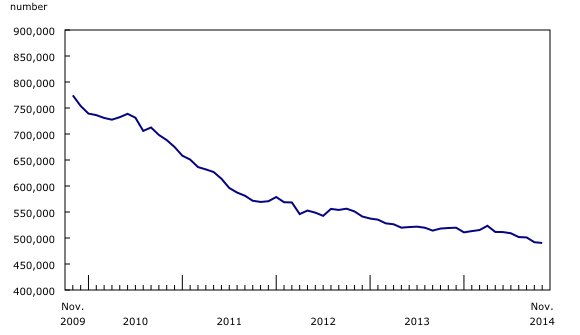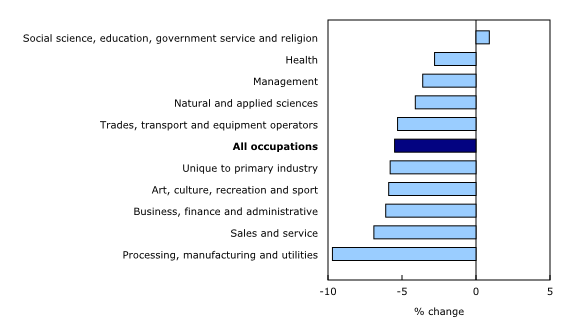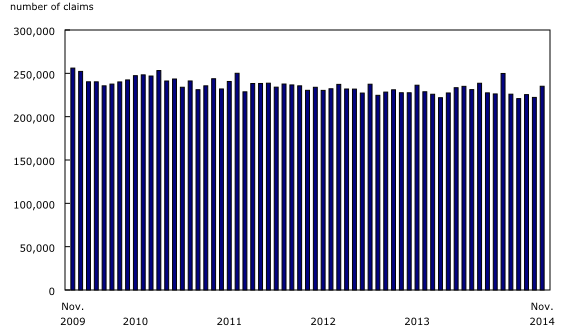Employment Insurance, November 2014
Archived Content
Information identified as archived is provided for reference, research or recordkeeping purposes. It is not subject to the Government of Canada Web Standards and has not been altered or updated since it was archived. Please "contact us" to request a format other than those available.
Released: 2015-01-22
The number of people receiving regular Employment Insurance (EI) benefits in November totalled 490,500, little changed (-0.3%) from the previous month. Compared with November 2013, the number of beneficiaries decreased by 28,800 or 5.5%.
Saskatchewan saw a decline in the number of beneficiaries in November, while there was a slight increase in New Brunswick. The number of beneficiaries in the remaining provinces was little changed between October and November.
The change in the number of regular EI beneficiaries reflects various situations, including people becoming beneficiaries, people going back to work and people no longer receiving regular benefits.
Provincial and metropolitan area overview
The number of people receiving regular benefits in Saskatchewan decreased by 1.7% to 10,600, with most of the decline coming from outside of the metropolitan areas (-2.1%). Saskatoon reported slightly fewer beneficiaries (-1.0%) between October and November.
In New Brunswick, there were slightly more people receiving benefits (+1.4%) in November. Saint John had an increase of 2.6%. Outside of the census metropolitan areas (CMAs) and census agglomerations (CAs), the number of beneficiaries rose by 1.5%. See "Geographical definitions" in the note to readers.
While the other provinces saw little change in the number of beneficiaries, this was not the case in some areas within the provinces.
In Newfoundland and Labrador, St. John's recorded an increase of 4.0% in the number of beneficiaries. This increase followed a period of declines over the previous six months.
In Nova Scotia, Halifax posted a slight decline of 1.1% in November, continuing a downward trend that began in the spring.
Of the six metropolitan areas in Quebec, four had fewer beneficiaries. Declines ranged from 2.5% in Trois-Rivières to 1.1% in Saguenay.
Of the 15 metropolitan areas in Ontario, 7 had fewer beneficiaries, with the largest declines in St. Catharines–Niagara (-3.7%), Kitchener–Cambridge–Waterloo (-2.6%) and Brantford (-2.6%). At the same time, Oshawa posted a 3.2% increase, while Peterborough reported a 2.9% rise.
In Manitoba, the number of beneficiaries among people living outside of the CMAs and CAs fell by 1.7%.
Regular Employment Insurance beneficiaries by occupation
In the 12 months to November, the number of beneficiaries in all occupation groups, based on EI recipients' last occupation, declined by 5.5%. There were fewer people receiving benefits in 9 of the 10 major occupation groups, most notably in occupations unique to processing, manufacturing and utilities (-9.7%).
People whose last occupation was in social science, education, government service and religion saw little change in the number of beneficiaries, edging up 0.9%.
Employment Insurance beneficiaries in major demographic groups
Compared with October, the number of beneficiaries decreased among men aged 15 to 24 (-3.0%) and declined slightly (-1.0%) for women aged 25 to 54. There was little change among other demographic groups.
On a year-over-year basis, the fastest rate of decline in the number of beneficiaries continued to be among people aged 15 to 24, down 8.8% for men and 8.6% for women. Over the same period, the number of beneficiaries among men aged 25 to 54 fell by 6.8%, a faster rate of decline than the 6.0% decrease for women in the same age group. Among people aged 55 and older, men posted a decline of 1.7%, while there was little change for women.
Employment Insurance claims
Nationally, there were more EI claims in November compared with October, up 5.8% to 235,100. The number of claims provides an indication of the number of people who could become beneficiaries.
Claims rose in every province, with notable increases in Quebec (+8.2%), Manitoba (+6.7%), Saskatchewan (+6.4%), Alberta (+5.6%) and Ontario (+5.1%).
Note to readers
Regular Employment Insurance (EI) benefits are available to eligible individuals who lose their jobs and who are available for and able to work, but cannot find a job. To receive EI benefits, individuals must first submit a claim. The number of claims provides an indication of the number of people who could become beneficiaries.
There is always a certain proportion of unemployed people who do not qualify for benefits. Some unemployed people have not contributed to the program because they have not worked in the past 12 months or their employment is not insured. Other unemployed people have contributed to the program but do not meet the eligibility criteria, such as workers who left their job voluntarily or those who did not accumulate enough hours of work to receive benefits.
All data in this release are seasonally adjusted. For more information on seasonal adjustment, see Seasonally adjusted data – Frequently asked questions.
EI statistics are produced from administrative data sources provided by Service Canada and Employment and Social Development Canada. These statistics may, from time to time, be affected by changes to the Employment Insurance Act or administrative procedures.
The number of regular EI beneficiaries and the number of claims received for the current and previous month are subject to revision.
The number of beneficiaries is a measure of all people who received EI benefits from November 9 to 15. This period coincides with the reference week of the Labour Force Survey (LFS). However, initial and renewal claims data are for the entire month.
EI statistics indicate the number of people who received EI benefits, and should not be confused with LFS data, which provide information on the total number of unemployed people.
Geographical definitions
Census metropolitan areas (CMA) and census agglomerations (CA) are population centres formed by one or more adjacent municipalities. A CMA, also referred to as a 'metropolitan area' in this release, must have a total population of at least 100,000. A CA must have a population of at least 10,000.
Data tables are also now available online. From the Browse by key resource module of our website under Summary tables, choose Subject, then Labour.
Data on Employment Insurance for December 2014 will be released on February 19, 2015.
Contact information
For more information, contact us (toll-free 1-800-263-1136; 514-283-8300; infostats@statcan.gc.ca).
To enquire about the concepts, methods or data quality of this release, contact Vincent Ferrao (613-951-4750; vincent.ferrao@statcan.gc.ca), Labour Statistics Division.
- Date modified:




